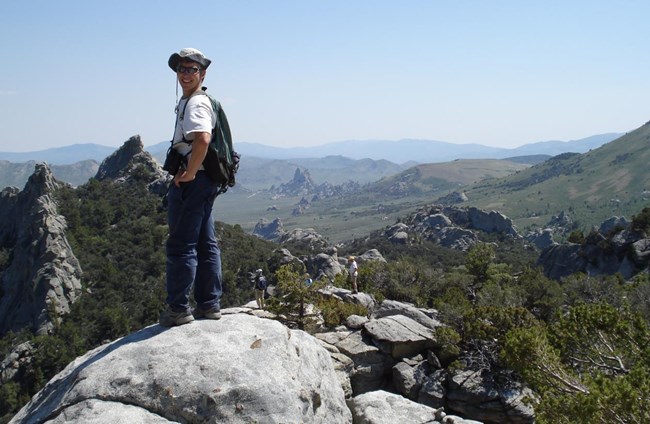Last updated: August 8, 2024
Article
Scientist Profile: Tom Rodhouse, Ecologist and Project Manager

NPS
Inspired by a family of birdwatchers
“I grew up with a father and a grandfather who were avid bird watchers. Ever since I was a kid I said I wanted to be an ornithologist. I remember sitting in my dad’s lap, listening to the old vinyl records of Peterson Field Guides with bird call recordings. That’s how I started to learn how to bird by ear. My family and I to this day incorporate birdwatching into our travels. It’s been great for going to new places and meeting new people.
“When I was out of college, I spent three years surveying and studying spotted owls. This species was a flashpoint issue for conservation of old growth forests and clashes over timber harvest. While I was doing that project, I began to fall in love with vistas—looking across beautiful landscapes and thinking about large-scale patterns; how you could see transitions in the distance from one kind of forest type to another. I became fascinated with understanding landscape patterns and GIS (geographic information systems).
“That's what kicked me back to graduate school and how I became an ecologist more broadly. I began my academic career in biogeography: the study of plants, animals, and these broad landscape patterns. I started asking questions about things like species distributions and how climate change, fire, or other kinds of past human land uses influence landscape patterns.

NPS
Tom's road to the National Park Service
“I had a couple of older, non-academic naturalists and conservation enthusiasts where I lived who were my mentors. One in particular took me under his wing. I helped him band raptor nestlings by climbing into the trees and rappelling off cliffs. After my master's degree, he connected me with somebody building the Upper Columbia Basin Network. They asked if I would do the vertebrate inventory for John Day Fossil Beds and I jumped at that chance. So, it was all by way of professional networking, word of mouth, and showing up when called for volunteer work. Initially I was brought in as a research assistant with the University of Idaho, then moved into a National Park Service position with the Upper Columbia Basin Network as the program matured. I've been here ever since.

NPS
Fire as a tool in conservation and management
“One of my favorite projects pertains to a rare plant that no one's ever heard of. Maybe that’s why I actually like it the best. It's called Lemhi penstemon (Penstemon lemhiensis) and it's one of maybe 200 and some odd species of penstemon that are all unique to North America.
One small park in our network, Big Hole National Battlefield, is serendipitously home to the largest population of this plant. In 2009, I started a long-term monitoring project to understand and follow the reproductive rates of penstemon in this battlefield. Based on this work, we concluded that the species depends on fire: without fire, it doesn't compete well with other vegetation.
“We built a prescribed fire experiment into this monitoring project. We burned part of the area and kept some of the areas unburnt, and I've had a long running annual survey comparing the burnt and the unburnt areas.
Besides the penstemon, there are other reasons to use prescribed fire as a management tool at this battlefield. We've been able to control and roll back an invasive weed, spotted knapweed (Centaurea stoebe), which is a real problem in the area. We’ve also been able to keep back the encroaching timber, woody vegetation, trees, and shrubs. Using fire has been a cool way to integrate managing the cultural battlefield landscape and biological conservation.
“I tend to do less field work these days because my role is more as a project developer, manager, and coordinator. But this is the one project that I've reserved to say: every year, I'm going out to work on my penstemon. And it's refreshing. It's like a vacation, a place where I get to recharge every year and enjoy the beautiful setting.

NPS
For Future Scientists...
“I’m doing more with early-career mentoring of interns and others coming up through the ranks. I try to give ideas and set up opportunities, then quietly get out of the way and create space for other people to excel in their own way. It’s fulfilling to see someone else getting super excited.
“One lesson: Don't sweat the details. The details do matter, but the issues that we're facing now are so big we need to really ask, how do we move the needle in terms of conservation goals?"
Interview and profile by Jeffrey Laroii, August 2020.
Additional Resources
Upper Columbia Basin Inventory & Monitoring Network
Video: "Lemhi penstemon monitoring at Big Hole National Battlefield, Montana."
